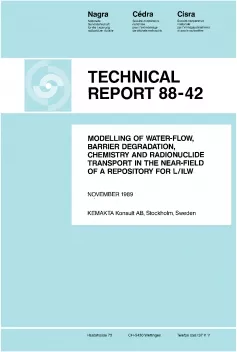
Technical Report NTB 88-42
Modelling of water flow, barrier degradation, chemistry and radionuclide transport in the near field of a repository for L/ILW
Performance assessment has been carried out for the near-field of a potential LLW/lLW repository in marl in Switzerland.
The host rock is assumed to be characterised by a system with 'small fractures' and one with 'large fractures', the hydraulic conductivity ranges from 4 × 10-10 – 4 × 10-9 [m·s-1] and the hydraulic gradient is 1 [m·m-1].
In the repository, low- and intermediate-level waste from reactor operation, decommissioning, reprocessing and medicine, industry and research will be disposed. Waste in drums and concrete containers will be placed in concrete-lined caverns which will be filled with a porous backfill material. One option is to include an additional engineered hydraulic barrier in the repository system. Its effects on repository performance have been studied.
The changes in physical and chemical properties of the barriers have been included in the assessment by calculating the leaching of mainly calcium from the concrete barriers. The hydraulic conductivities of the engineered barriers are assumed to vary between 10-11 and 10-8 [m·s-1] after degradation.
Radionuclide transport can be determined by both advection and diffusion, depending on the hydraulic conductivities in the near-field. The water flow rates within the barriers have been calculated. The results show that the water flow rates within the porous backfill may increase by more than one order of magnitude compared to the water flow rate in the undisturbed host rock. The water flow rate through the waste matrix is never significantly larger than that in the host rock because it has been assumed that the porous backfill always has higher hydraulic conductivity than the waste matrix.
The water flow rates within the near-field have been used to calculate the fractional release rates of species with different sorption properties. Different modelling approaches have been used: (1) a sophisticated advection diffusion transport model using the same model domain as in the hydraulic modelling, (2) a plug-flow model, and (3) a mixing-tank model.
The fractional release rates obtained with the advective-diffusive transport model have been transformed into radionuclide release rates taking into account radioactive decay. The results show that sorption by barrier materials will be the most important mechanism for reducing the release of radionuclides and will influence both the rate and the tune of maximum release from the near-field. The rate of barrier degradation is of particular importance for the release of short-lived, weakly sorbed radionuclides. The quality of the barriers and the introduction of an additional high quality barrier will also be of importance for the release of short-lived, weakly sorbed radionuclides. Physical containment by engineered barriers can only be guaranteed during a limited tune period. Therefore, the releases of long-lived radionuclides are only slightly influenced by the quality and rate of physical degradation of the barriers.
Processes which could decrease radionuclide releases by orders of magnitude are slow corrosion of metal with embedded nuclides and limitation of solubility in the waste matrix. These processes can play a major role for some specific radionuclides and waste types. For example, the release rate of Ni-59 from certain waste types decreases by one to four orders of magnitude when the release is restricted by corrosion of the waste or limited by the low solubility (10-5 kmol·m-3).
